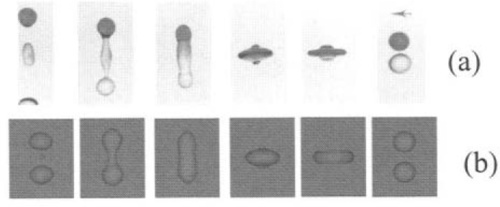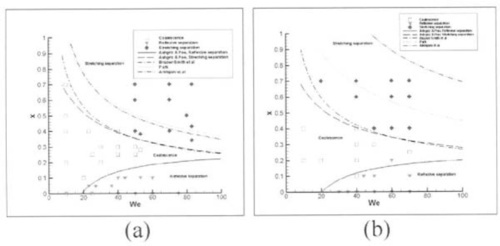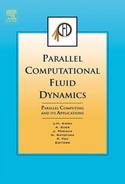A numerical analysis on the collision behavior of water droplets
H.W. Nama; E.J. Kima; J.H. Baeka[email protected] a Department of Mechanical Engineering Pohang University of Science and Technology(POSTECH) San 31, Hyoja-Dong, Nam-Gu, Pohang, KyungSangBukDo, South Korea
1 Introduction
The droplet collision is an important phenomenon that can be seen in nature, such as atmospheric raindrop formation, spray characteristic, etc. In the process of spray formation, distributions of droplet size can be affected by the collision angle and the relative velocity of the droplet collision. Recently, the process of spray formation is used frequently in a lot of industrial field applications such as an internal-combustion engine, surface handling, etc. Therfore it is very important to fully understand the droplet collision phenomenon.
Very complex flow phenomena appear after two droplets collide each other. Droplet collision behavior is normally divided into four categories; bouncing, coalescence, stretching separation and reflexive separation. For example, the behavior of droplet collision is affected by a species of working fluid; usually bouncing occurs at collision of hydrocarbon droplets, barely at collision of water droplets. And the droplet collision behavior is normally affected by Weber number, droplet size-ratio and impact parameter. Ashgriz and Poo[1] and Brazier-smith at al[2] conducted experiments on the collision of water droplets and found some critical conditions where the separation occurs. Jiang et al[3] and Qian and Law[4] provided various experimental data on the collision of hydrocarbon droplets. Schelklc and Frohn[5] performed numerical simulations using Lattice Boltzmann method. And Rieber and Frohn[6] did also on the central and non-central collision for droplet size ratio of 1 using 3D VOF method.
In this paper, we performed a series of numerical simulations on the droplet collision for various conditions of Weber number, impact parameter and droplet size-ratio, and compared the results with some experimental results and other theoretical predictions.
2 Theories of droplet collision
2.1 Droplet collision phenomena and dimensionless number
One of the important parameters associated with the collision outcome is the relative velocity of colliding droplets. The relative velocity is defined as follows,
where a is the collision angle, UL the velocity of larger droplet and Us the velocity of smaller droplet. Another important parameter that governs collision outcomes is the impact parameter. Impact parameter, X, is defined as the distance from the center of one droplet to relative velocity vector located on the center of the other droplet. Using these two parameters, the following dimensionless numbers can be defined,
where Re is the Reynolds number, We the Weber number, Δ droplet size-ratio, and x the dimensionless impact parameter, ρ and μ are the density and viscosity of the droplets respectively and σ is the surface tension coefficient. dL is the diameter of larger droplet and ds is the diameter of the smaller droplet.
The range of Reynolds number in this paper is between 500 and 4000. According to previous investigations, Reynolds number in the range of 500 to 4000 does not play a significant role on the outcome of the collision. Therefore main parameters that can influence the collision outcome are Weber number, droplet size-ratio and impact parameter. Weber number is controlled by changing the relative velocity and the impact parameter by changing the collision angle
2.2 Reflexive separation
When two droplets are merging, the overall surface area is decreased, resulting in the reduced surface energy. Reflexive separation occurs when the surface energy of new droplet is insufficient to contain the internal flow of droplet. Usually, reflexive separation occurs at a large Weber number and a small impact parameter. Small impact parameter means that the collision is close to the head-on collision.
Ashgriz and Poo[1] assumed nominal spherical droplet which has same volume with two droplets. Using the relation between the kinetic energy and the surface energy of the nominal spherical droplet, they found theoretical prediction separating the reflexive separation region from the coalescence region.
2.3 Stretching separation
Stretching separation occurs when the region of overlap between two colliding droplets is small. While the interface of two colliding droplets is merging, the remaining volumes, except the interaction region, continue to move in the opposite directions, stretching the interface and ultimately severs the connection.
Ashgriz and Poo[1] found a criterion for the stretching separation. Earlier Park[7] considered an equilibrium between the surface energy and momentum on the colliding region, and derived a criterion for the stretching separation. Brazier-Smith et al[2] assumed that the rotational energy excess the surface energy for stretching separation and derived a relation. Arkhipov et al[8] assumed the rotating system which has a constant angular velocity and derived a criterion of stretching separation using the variation quantity of the minimal potential energy.
3 Numerical method
VOF method is used for free surface tracking, in which, each phase is identified by using volume fraction. The volume fraction and the volume evolution equation are defined as following equations.
In this paper, two working fluids are specified as air and water, assumed as incompressible and insoluble. The Navier-stokes equations are
where uc is the fluid velocity, p is the pressure. Governing equations are solved by using fractional step method on the cell centered grid. And time marching scheme for convection term is Adams-Bashforth method and, for viscous term, Crank-Nicolson method is applied. CSF(Continuum Surface Force) model[9] is used for the application of surface tension, where the surface tension is represented as a volumetric force in the source term of the Navier-Stokes equation.
4 Numerical results
In the previous investigations, a few representative experimental results were numerically analyzed in case of the drop-size ratio, 1, for two droplets. In this paper, performed are numerical simulations on the droplet collision for different size ratio with the various boundary conditions. The results are compared with previous experimental results as well as theoretical predictions.
4.1 Collision at the size ratio of Δ = 1
Results of numerical simulation for droplet size ratio of 1 will be discussed in this section with Weber number of 5 to 100 and dimensionless impact parameter of 0 to 1.
Figures 1 to 3 show results of reflexive separation. Usually reflexive separation occurs at large Weber number and small impact parameter. While Fig. 1(a) and Fig.2(a) are the experimental results of Ashgriz and Poo[1], Fig.1(b) and Fig.2(b) is numerical ones. There could be some time lag between the experiments and the numerical results respectively, but in generally, numerical results agree well with experiments. Results at the condition of We=40 and We=83 are shown in Fig. 2 and Fig. 3 respectively. In Fig.2, one satellite droplet is formed but in Fig.3, two satellite droplets are formed. Numerical results show that the number of satellite droplet increases with Weber number which coincide with previous experiments. Figure 4(a) shows various theoretical predictions dividing the regions of coalescence, reflexive separation and stretching separation. While a solid line is the theoretical prediction of Ashgriz and Poo[1] differencing the region of reflexive separation from stretching separation region, the inverted triangles indicate reflexive separation region of numerical results. Our numerical results shows good agreement with theoretical prediction of Ashgriz and Poo[1].




Figure 5 shows results of stretching separation. Usually stretching separation occurs at the conditions of large Weber number and large impact parameter. Since stretching separation is affected by the interaction area of collision, the interaction region reduces if impact parameter increases, resulting in a higher stretching energy. In Fig.5, the drop size after the collision is found to be different from each other and this reveals the mass transfer during the collision. Results on the number of satellite droplets after stretching separation is shown in Fig.6(a) and the experimental results of Ashgriz and Poo[1] and the numerical result of Ko[10] are shown in Fig.6(b). Both our numerical results and previous investigaton result show the same tendency that the number of satellite droplets is increased up to critical impact parameter which has the maximum number of satellite droplets and then decreases. The maximum number of satellite droplets appears at the range of impact parameter 0.4 to 0.6. In Fig.4(a), various theoretical predictions dividing the region of coalescence from stretching separation region are shown by several lines. While Ashgriz and Poo[1] and Brazier-Smith et al[2] derive theoretical prediction using the assumption that the combined mass at any phase of the collision process can be transformed into a nominal spherical droplet, Park[3] and Arkhipov et al[4] derived theoretical prediction using the energy equations of the volume in the interaction region. In Fig.4(a), symbols of diamond are numerical results indicating stretching separation region and those of square indicating coalescence region. Our numerical results show a large discrepancy with the theoretical prediction by Park[3] and Arkhipov et al[1]. Numerical results show good agreement with the theoretical prediction of Ashgriz and Poo[1] and Brazier-Smith et al[2], as well as the experimental results of Ashgriz and Poo[1]. From the comparison, the theoretical predictions of Ashgriz and Poo[1] and Brazier-Smith et al[2] are found to be more reasonable.


4.2 Collision at the size ratio of Δ = 0.75
The results of numerical simulation for droplet size-ratio of 0.75 will be discussed in this section.
In Fig.4(b), the reflexive separation region of numerical results agree well with the theoretical prediction of Ashgriz and Poo[1] as in the results of droplet size ratio of 1. However, the reflexive separation region for droplet size ratio of 0.75 become smaller and the coalescence region is extended compared with the regions for droplet size ratio of 1. This is due to the decrease of the repulsion force. Decreasing of the repulsion force makes coalescence occur more often and therfore under the same Weber nuber condition, maximum impact parameter x for reflexive separation for droplet size ratio of 0.75 is lower than that for droplet size ratio of 1. When two droplets with different size collide as shown in Fig.7, the larger droplet becomes smaller after the collision, but smaller drop becomes larger because it takes some momentum from the larger drop. It seems that the mass transfer affect to decrease of reflexive separation region, resulting in the decrease of repulsion force.

The stretching separation region for droplet size ratio of 0.75 as shown in Fig.4(b) becomes smaller as compared with the regions for drop-size ratio Δ=l. It is found that under the same Weber number, stretching separation for droplet size ratio of 0.75 occur at larger impact parameter than that for drop-size ratio of 1. In case of the collision of two droplets with different size, pressure of the smaller droplet is higher than that of larger droplet, and therefore mass transfer occurs from the smaller droplet into the larger droplet. This flow disturbs stretching separation, resulting in smaller stretching separation region. And stretching separation region of the numerical results agrees well with those of the theoretical prediction of Ashgriz and Poo[1] and Brazier-Smith et al[2] as in the result of drop-size ratio Δ=l. Also, the numerical results show a more considerable difference compared with the prediction of Park[7] and Arkhipov et al[8] than those for drop-size ratio of 1 . From the results of the collision for droplet size ratio of 0.75, the theoretical predictions of Ashgriz and Poo[1] and Brazier-Smith et al[2] are found to be more reasonable.
5 Conclusions
A series of numerical simulations on the droplet collision for various conditions of Weber number, impact parameter and droplet size-ratio are performed and compared with some experimental results and other theoretical predictions. From the results, three categories of collision (coalescence, reflexive separation, stretching separation) show a good agreement with the previous theoretical predictions of Ashgriz and Poo[1] and Brazier-Smith et al[2] and with the experimental results by Ashgriz and Poo[1], But not with the theoretical predictions of Park[7] and Arkhipov et al[8]. Results of stretching separation show the same tendency that the number of satellite droplets is increased up to critical impact parameter which has the maximum number of satellite droplets and then decreases to zero. Compared with the regions for droplet size ratio of 1, regions of reflexive and stretching separation for droplet size ratio of 0.75 become smaller and the region of coalescence is extended in result.



